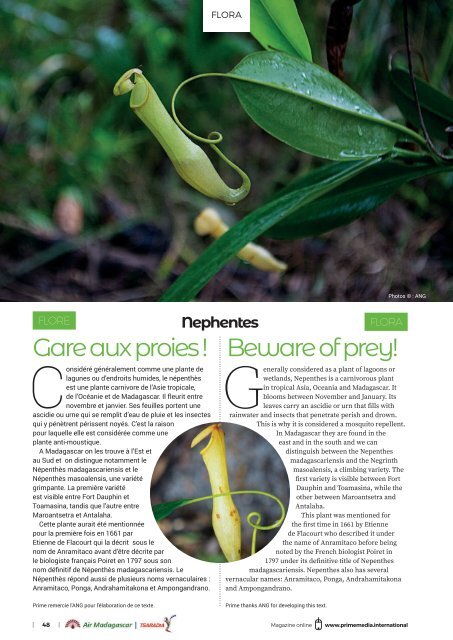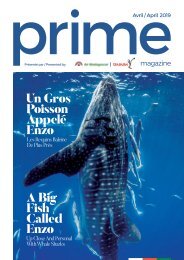PRIME MAG - AIR MAD - OCTOBER 2018 - SINGLE PAGES - LO-RES
You also want an ePaper? Increase the reach of your titles
YUMPU automatically turns print PDFs into web optimized ePapers that Google loves.
F<strong>LO</strong>RA<br />
Photos © : ANG<br />
F<strong>LO</strong>RE<br />
C<br />
onsidéré généralement comme une plante de<br />
lagunes ou d’endroits humides, le népenthès<br />
est une plante carnivore de l’Asie tropicale,<br />
de l’Océanie et de Madagascar. Il fleurit entre<br />
novembre et janvier. Ses feuilles portent une<br />
ascidie ou urne qui se remplit d’eau de pluie et les insectes<br />
qui y pénètrent périssent noyés. C’est la raison<br />
pour laquelle elle est considérée comme une<br />
plante anti-moustique.<br />
A Madagascar on les trouve à l’Est et<br />
au Sud et on distingue notamment le<br />
Népenthès madagascariensis et le<br />
Népenthès masoalensis, une variété<br />
grimpante. La première variété<br />
est visible entre Fort Dauphin et<br />
Toamasina, tandis que l’autre entre<br />
Maroantsetra et Antalaha.<br />
Cette plante aurait été mentionnée<br />
pour la première fois en 1661 par<br />
Etienne de Flacourt qui la décrit sous le<br />
nom de Anramitaco avant d’être décrite par<br />
le biologiste français Poiret en 1797 sous son<br />
nom définitif de Népenthès madagascariensis. Le<br />
Népenthès répond aussi de plusieurs noms vernaculaires :<br />
Anramitaco, Ponga, Andrahamitakona et Ampongandrano.<br />
Nephentes<br />
F<strong>LO</strong>RA<br />
Gare aux proies ! Beware of prey!<br />
Generally considered as a plant of lagoons or<br />
wetlands, Nepenthes is a carnivorous plant<br />
in tropical Asia, Oceania and Madagascar. It<br />
blooms between November and January. Its<br />
leaves carry an ascidie or urn that fills with<br />
rainwater and insects that penetrate perish and drown.<br />
This is why it is considered a mosquito repellent.<br />
In Madagascar they are found in the<br />
east and in the south and we can<br />
distinguish between the Nepenthes<br />
madagascariensis and the Negrinth<br />
masoalensis, a climbing variety. The<br />
first variety is visible between Fort<br />
Dauphin and Toamasina, while the<br />
other between Maroantsetra and<br />
Antalaha.<br />
This plant was mentioned for<br />
the first time in 1661 by Etienne<br />
de Flacourt who described it under<br />
the name of Anramitaco before being<br />
noted by the French biologist Poiret in<br />
1797 under its definitive title of Nepenthes<br />
madagascariensis. Nepenthes also has several<br />
vernacular names: Anramitaco, Ponga, Andrahamitakona<br />
and Ampongandrano.<br />
Prime remercie l'ANG pour l'élaboration de ce texte.<br />
Prime thanks ANG for developing this text.<br />
| 48 | Magazine online www.primemedia.international















